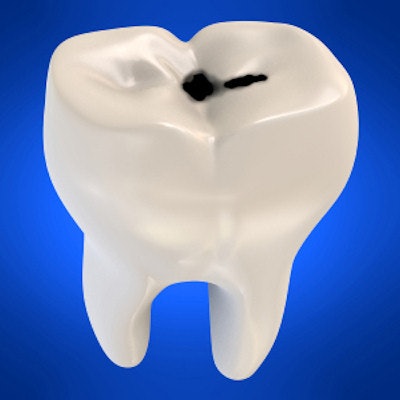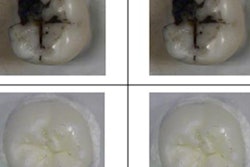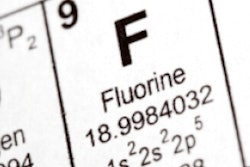
Silver diamine fluoride (SDF) was found to be safe and 100% effective in stopping active caries in primary teeth of at-risk children and was also well-accepted by their parents in a new study, published in the Journal of Public Health Dentistry.
The small, short-term clinical trial included the use of SDF on 100 carious lesions on the primary teeth of 30 children, and the researchers found all the lesions were arrested, bolstering advocates' claims for wider use of the substance.
"Our results suggested SDF was effective in arresting active caries lesions in primary teeth in young children and was well-accepted by parents," the authors wrote (J Pub Health Dent, July 27, 2017).
The study was led by Jennifer Clemens, DMD, from the College of Graduate Health Studies at A.T. Still University Missouri School of Dentistry and Oral Health.
Arrested developments
More than 40% of young children in the U.S. have caries and more than 20% of children have untreated decay, so finding a cost-effective treatment for caries in this population is crucial, the study authors noted. Silver diamine fluoride has been identified as an inexpensive topical treatment that successfully arrests dental decay. In 2014, the U.S. Food and Drug Administration (FDA) classified SDF as a fluoride.
The researchers enrolled 32 children between the ages of 2 and 5 from a community dental clinic in Oregon for their study. These children had 118 active caries lesions in their primary teeth, most of which (109) were posterior in location. The researchers excluded 16 lesions when those children dropped out of the study, leaving 102 lesions.
The lesions were treated with one or two applications of 38% SDF after baseline examination. The teeth were dried and isolated before SDF application directly on the lesion with a microbrush. The SDF was absorbed for up to two minutes (mean ± standard deviation of the duration of SDF exposure was 83.56 ± 31.2 sec). After application, the lesion was covered by a small amount of fluoride varnish. The parents and the child were then reminded that the child was not to eat or drink for an hour after the application.
The researchers evaluated the efficacy of SDF based on clinical outcomes, in which dark, hard, and black lesions with no pain or infection were considered positive outcomes. The following outcomes were considered to indicate treatment failure:
“Our results suggested SDF was effective in arresting active caries lesions in primary teeth in young children and was well-accepted by parents.”
- Progression of the lesion
- Yellow, soft lesion
- Pain
- Infection
The children were re-evaluated at three-week and three-month recalls to assess color and consistency changes in lesions. The researchers also interviewed the parents of the patients to find out about any symptoms of pain or infection their children might have expressed. They were also surveyed regarding subjective feelings about SDF.
At the three-month recall, the researchers found all 102 carious lesions were arrested. The authors also reported that the duration of SDF application was not associated with decay arrest.
"There was no significant association between length of time SDF was applied to teeth and effectiveness of the SDF," the authors wrote.
The children and their parents also cited no pain or infection from an SDF-treated tooth. In addition, the parents of these children had a favorable impression of the ease of application of SDF, its taste, and the aesthetics of the treatment.
Discoloration addressed
The authors noted several limitations to their study, including that a randomized clinical trial would be a more effective and valid study design. However, a hard dentin surface and the dark color of an arrested lesion are considered valid clinical indications for a positive outcome, and it would be difficult to achieve the appropriate blinding required for a randomized clinical trial because of the dark color of arrested lesions, they wrote.
The authors also recommended a longer-term study to help determine the effectiveness of SDF.
"It would be useful to monitor arrested lesions for a longer term to assess if arrest persists over time," they wrote. "Additional studies are needed to follow patients for longer periods of time, to determine how long one application of SDF effectively arrests caries lesions, and to assess the required frequency of recall and SDF reapplications."
Their study also included only one examiner, and the authors recommended adding a second examiner to improve assessment reliability. They noted, however, that the current examiner was a trained and experienced dentist who followed the current standard of care and criteria for caries diagnosis.
In addition, the authors acknowledged that one of the biggest issues with SDF is the tooth discoloration associated with its application. They reported their trial is the first clinical study to offer information about parental acceptance of SDF, which was positive, as noted above.
"Dentists should counsel parents about the ease of SDF application to improve parental acceptance of this treatment modality," the authors concluded.



















